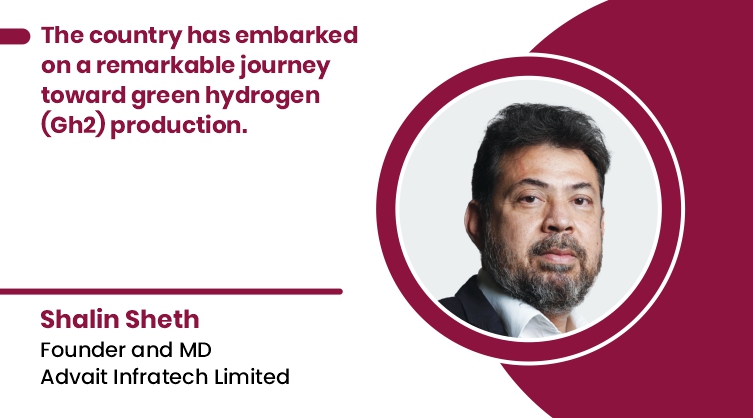India registering the highest growth in the energy sector
By EPR Magazine Editorial November 3, 2023 1:44 pm IST
By EPR Magazine Editorial November 3, 2023 1:44 pm IST

The country has embarked on a remarkable journey toward green hydrogen (GH2) production.
India, a rapidly developing nation, is on the cusp of a significant economic transformation, and with that comes a growing energy demand. To balance this economic growth with environmental responsibility, India has embarked on a remarkable journey toward green hydrogen (GH2) production. Shalin Sheth- Founder and MD, Advait Infratech, shares his opinion on the green energy landscape.
India’s energy landscape
Over the past decade, India’s economy has displayed impressive growth while maintaining inflation control. The country’s ambitious goal is to double its GDP, reaching USD 7 trillion by 2030. India, currently ranking third in the world for energy consumption, is projected to witness the highest percentage growth in the energy sector in the coming years. However, it faces challenges related to its substantial reliance on imported fossil fuels, which cost the nation over USD 90 billion annually. To align with its climate targets, India has initiated steps to decarbonise its economic growth path.
Green hydrogen role
Green Hydrogen (GH2) is key to achieving India’s climate goals and sustainable energy security. While electricity accounts for only around 17 percent of total energy use in the country, efforts to reduce greenhouse gas emissions from the remaining 83 percent are imperative. GH2 offers a zero-emission energy source and can be utilised in hard-to-abate sectors like shipping, steel, aviation, and industries already using Grey Hydrogen derived from natural gas, such as refineries and fertilisers.
Overcoming the challenges
To make green hydrogen economically viable in India, several challenges must be addressed. First and foremost, there is a need for consistent and low-cost renewable energy sources to power green hydrogen (GH2) production. India should invest in renewable energy infrastructure to meet this requirement. Additionally, India must develop the capability to manufacture electrolysers domestically to reduce import dependence. This indigenous manufacturing capability can help lower production costs.
Another challenge is the secure procurement of critical minerals required for electrolysis. To address this issue, India should forge geo-political partnerships to ensure a steady supply of these minerals. Establishing GH2 production hubs near demand centres can help reduce transportation costs, making GH2 more economically viable.
Sustainable water usage is another critical aspect of GH2 production. India should invest in sustainable water usage practices, including industrial/municipal wastewater or seawater for electrolysis. Continuous research and development efforts are necessary to enhance electrolyser efficiency, stack life, and reduce water and power requirements. Incentives such as tax and duty waivers can encourage GH2 projects and renewable energy plants, promoting the growth of this industry and facilitating exports.The Indian government has recognized the importance of GH2 production and has introduced various initiatives to support its development. The National Hydrogen Mission, a cornerstone of India’s GH2 strategy, aims to manufacture five million tonnes of GH2 by 2030. In addition to this mission, the government has prioritized grid access for manufacturers and renewable energy plants to prevent delays and has offered incentives for meeting renewable purchase obligations.
Energy storage options, allowing producers to store excess renewable energy for up to 30 days, have been introduced to enhance efficiency in GH2 production. Furthermore, incentives in the form of Renewable Purchase Obligation (RPO) incentives are provided to hydrogen manufacturers for fulfilling their RPO obligations. The Ministry of New and Renewable Energy has also streamlined processes by launching a dedicated web page for India’s Green Hydrogen mission, providing comprehensive information on objectives, frameworks, strategic interventions, pilot projects, and more. Additionally, waiving inter-state transmission charges for 25 years encourages the growth of GH2 infrastructure, further supporting its development and adoption.
Progress in green hydrogen pilots
The country showcased its progress in GH2 technology during the ‘Green Hydrogen Pilots in India’ conference in September 2023. Additionally, India is nearing completion of the R&D roadmap for the National Green Hydrogen Mission and has introduced its green hydrogen standard to maintain environmental sustainability.
Advait Infratech secured India’s inaugural green hydrogen project of its kind for THDC India, involving the installation of a 300KW electrolyser and a 70 KW fuel cell. This setup will generate electricity continuously for 12 hours, providing sustainable energy for both lighting and residential use.
Ensuring reliable renewable energy availability
Collaboration between central and state authorities is necessary to establish clear pricing for round-the-clock (RTC) renewable energy power while utilising grid-scale battery storage can maximise its utilisation. Reducing banking, transmission, and distribution charges is essential to lower power costs. States must promptly release GH2 policies to provide incentives such as duties and tax exemptions, subsidies, infrastructure facilities, and banking.
Green hydrogen should be viewed as a complement to other alternative energy sources, not a standalone solution. Despite the challenges of production costs and regulatory support, GH2 is vital for India’s transition to clean energy.
We use cookies to personalize your experience. By continuing to visit this website you agree to our Terms & Conditions, Privacy Policy and Cookie Policy.